Introduction
In resource poor settings, malnutrition and low levels of education are still major problems, especially for girls. A recent national survey in Pakistan revealed that in rural areas of Sindh-Pakistan, 18.3% girls and 14.6% boys were stunted1. In 2005, the literacy rate among females aged 15 years or over in Pakistan was 36%2. Gross primary enrolment for 2005 was 77% among girls, compared with 94% among boys2. In rural settings only 22% of girls aged over 10 years have completed primary level or higher schooling, compared with 47% boys3. Low literacy and educational attainment is a complex problem associated with the low social status of women, and little perceived benefit from educating girls.
The literature suggests that malnutrition among those 5-12 years is high in Pakistan1,4. The consequences of malnutrition and poor literacy rates for women and girls in resource-poor settings have been well documented. Childhood malnutrition and infectious diseases not only account for a major proportion of mortality5, but also for two-thirds of the disease burden6. Malnutrition and the resultant lowered immunity are the major underlying factors in approximately half of the 740 000 child deaths annually, worldwide7. The protein-energy, malnutrition-infection complex is a strong predictor of functional impairment in a wide range of biological, behavioural and social dimensions among children and adults, especially those in developing countries8,9. Developmental impairments, the long-term sequel of malnutrition10, include diminished learning ability in school11, a high risk of mortality among women during childbirth12, and of poor pregnancy outcomes, such as intrauterine growth retardation and infant mortality13. There is also evidence that malnutrition in childhood impairs the capacity for physical work later in adulthood14. In Pakistan, malnutrition is not simply a personal health hazard, but also a serious impediment to national development.
In the face of these challenges the Government of Pakistan implemented a large scale intervention to combat malnutrition and increase school enrolment among primary school girls, based on a successful pilot15. The program conducted baseline training in 4383 schools that catered for 439 852 children in 29 of the poorest districts in the country. However, feeding was conducted in only 4035 schools for 417 665 girls. The majority of schools where feeding was not initiated were included late in the project. While communities were mobilized to send girls to schools, feeding could not be initiated as funds were not released by the government.
The major implementation strategy was to empower women in villages near the project schools. Rural women volunteered to serve on school committees that managed the feeding program. Their activities included participation in purchasing food, and in preparing and serving meals to the girls. This report documents and evaluates the impact of this large-scale intervention on the nutritional status and school enrolment of primary school girls. Implications for policy are drawn from the findings.
Pakistan
Pakistan is situated in the north-western part of South Asia. The state consists of four provinces (Fig1): Punjab, Sindh, North West Frontier Province (NWFP), and Balochistan; and some federal units including Northern Areas, and Azad, Jammu and Kashmir (AJK).
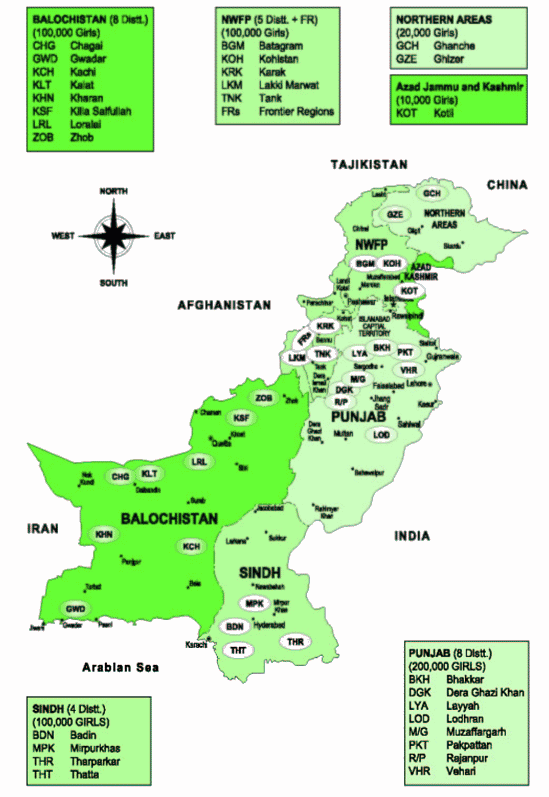
Figure 1: Map of Pakistan showing the project's districts.
Pakistan is the world's seventh most populous country and has one of the highest population growth rates. The population density of the country is estimated to be 166 persons per square kilometre; and 45% of the population is under 15 years of age16.
The country's economy is mainly agrarian, with agriculture contributing 22% to the gross domestic product17. The gross national product per capita is US$847, and it is estimated that 23.9% of the population lives below the poverty line17.
Methods
Intervention
The intervention, the Tawana Pakistan Project (TPP), was funded by the Government of Pakistan. The project was implemented and managed by a consortium including: the Aga Khan University, Department of Community Health Sciences (AKU/CHS); the National Implementation Unit; and the Pakistan Bait-ul-Maal, the latter two being units of the Ministry of Social Welfare and Special Education. In a public-private partnership, AKU/CHS provided technical support for the design of the project, and trained and managed 11 non-governmental organizations (NGO) that supported local governments in project implementation. Comprehensive training was provided to 663 fieldworkers, 4383 community organizers (COs), 4336 school teachers, and 94 134 community women, many of whom volunteered in the School Tawana Committees (STC). The project was implemented in all four Pakistan provinces, Northern Areas and AJK between September 2002 and June 2005. Extensive administrative records were maintained relating to costs, volunteers, training and school committee meetings.
The project provided freshly prepared, balanced school lunches made from locally available food items. Community development strategies were used to mobilize the local communities. The model used was similar to the 'Focusing Resources on Effective School Health' (FRESH) model suggested by WHO, UNESCO, UNICEF and the World Bank18. Community women who volunteered were trained to manage the feeding program, which included managing funds, purchasing goods, planning meals, preparing the meals and serving the food. A substantial amount of training was provided to these volunteers to ensure the quality of the meals, as described in the Final Report of the Tawana Pakistan Program19. The average cost of a meal was between 6.07 and 7.14 Pakistani Rupees, approximately US10 cents.
The specific foods chosen and the actual menus were determined by the community and monitored by the supervising and training NGOs. The volunteers were trained to plan balanced meals which included one food from each of the three food groups: for energy carbohydrates (grains); for protection fruits/vegetables; and for growth protein (meat, dairy or pulses). The project carefully monitored the menu composition and found improvement over the project period (more menus with the three food groups represented). However other issues related to the quality (specific quantities of micronutrients) or quantity of the food served to each girl were not monitored. Based on average prices of foods and the average caloric needs of primary-school aged girls, it was determined in the planning phase that the girls would receive one-third of their daily caloric intake from the school lunch program. Volunteers were trained to serve equal portions of food to the girls and to follow specific program hygiene practices.
Data sets and definitions
A variety of data were collected as part of the monitoring and evaluation of this large-scale intervention. Mixed methods were used to evaluate the impact of the intervention.
Nutritional status: Baseline weights and heights were recorded for each girl at the initiation of the project, for which scales and measuring tapes were provided to each school. The ages of the girls were determined using local area calendars which were developed by each school Tawana committee, according to important local and national events. Community organizers hired by the project and teachers were trained and supervised by NGO staff in routine anthropometric measurements. The measurements were conducted on each girl quarterly. This report analyses the records of girls with at least two sets of body measurements at least 6 months apart.
Malnutrition was defined using three standard indicators: stunting, underweight, and wasting. Children below -2 standard deviations from median height-for-age of a reference population were defined as stunted. Similarly, children below -2 standard deviations from median weight-for-age of the reference population were defined as underweight. And children below -2 standard deviations from the median weight-for-height of the reference population were defined as wasted20. The changes in nutritional status were calculated by the number of girls for whom there was a change in the standardized nutritional status scores (z scores).
There were a total of 417 665 girls inducted into the program over the project period. Of these, 203 116 girls received at least two sets of body measurements at least 6 months apart. The major reasons for this drop included late entry to the program; less than 6 months between measurements; and absenteeism on the days of the second measurement. There were no statistically significant differences in the levels of stunting and wasting between the two groups of girls. Neither were there important differences in nutritional status at province/area or district level between the girls in the analytical group and the other group. It was concluded that the analytical sample was not biased in relation to a major analytical variable of the study, malnutrition.
Enrolment and anthropometric data: Enrolment was noted before and after the project on 4383 schools where COs were trained. Anthropometry was conducted when each girl was inducted into the program and then quarterly. The anthropometric analysis was conducted on 203116 girls in 3356 schools for which both baseline and post-Tawana data was available.
Percent increase in enrolment is calculated by subtracting the enrolment numbers in a school at the end of the project from the enrolment at the beginning, and dividing the difference by the enrolment before the intervention.
Pre- and post-intervention community surveys: Consecutive cross-sectional household surveys were conducted at baseline between April and October 2003, and at the end of the project, between August and October 2005.
For the surveys, 5% of the estimated 5000 target project schools were selected, yielding 250 sample schools. Twenty households were selected in the communities adjacent to these selected schools, providing 5000 households. The same communities were sampled in the pre- and post-intervention surveys.
A three-stage sampling strategy was utilized. First, half of the districts (15 of 29) serviced by each of the NGOs were selected at random. Each district is divided into tehsils, and a 5% sample of the schools was selected in each tehsil. Households in each community adjacent to the selected schools were numbered at the time of the survey, and 20 households were selected through systematic random sampling for interview for both the pre- and post-intervention surveys.
Survey teams were mounted by the NGOs and trained by AKU/CHS. Field interviewers and supervisors received 6 hours theoretical training and one day of field-based practical training.
Semi-structured interviews were conducted with women, preferably the mothers of school children, in the selected households. The questionnaire included modules concerning nutrition, education and community participation. The participants were asked about the food consumed in their last lunch. The food items reported for each meal were coded into one of the three food groups, using standard nutritional criteria to determine whether or not meals were balanced.
Focus group discussions: Focus group discussions (FGDs) were conducted in villages selected for the community survey. Each group consisted of 8-10 participants, including school committee members, mothers, local community women, 'lady health workers' and elected female members selected in a convenience sample. These FGDs collected perceptions about health, nutrition and the schools (teacher attendance, schools timings, discipline in the school and school hygiene). One trained field worker used a semi-structured guide to lead each focus group. A second trained fieldworker took notes during the discussion and made verbatim transcription of key responses; the notes were coded by AKU staff.
Statistical methods
Differences in anthropometry and enrolment data at the baseline and at the end of the project were tested using McNemar's test. Differences between the two sample-based pre- and post-survey data were tested by a weighted ϐ2 test. All statistical testing was performed using SAS v 9.1 (SAS Institute Inc., Cary, NC, USA). Survey estimates and statistical testing were calculated using weights and a design effect estimated to reflect the complex sample design.
Results
The number of districts, schools and girls by area reached by the program are presented (Table 1). At baseline, 23.2% girls were stunted and 14.3% wasted. This baseline nutritional status may be more fully understood with ethnographic reports of hunger from these communities. Reports of hunger from the schools were common.
The intervention decreased malnutrition, increased enrolment and improved dietary knowledge in the communities. Over the study period, improvements were observed in the three measures of nutritional status (Fig2). Wasting, or acute malnutrition, decreased by 45% (McNemar's test p < .001). Underweight girls declined by 21.7% (McNemar's test p < .001). Stunting, a measure of chronic malnutrition, decreased by 6% (McNemar's test p < .001).
Table 1: Districts, schools and beneficiaries included in the before-and-after analysis by province
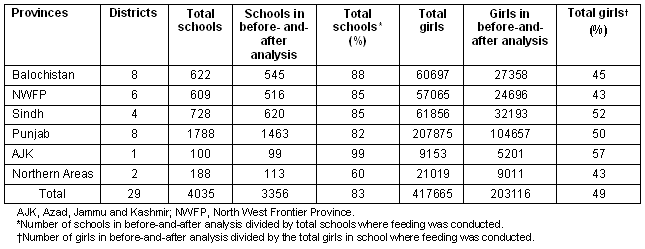
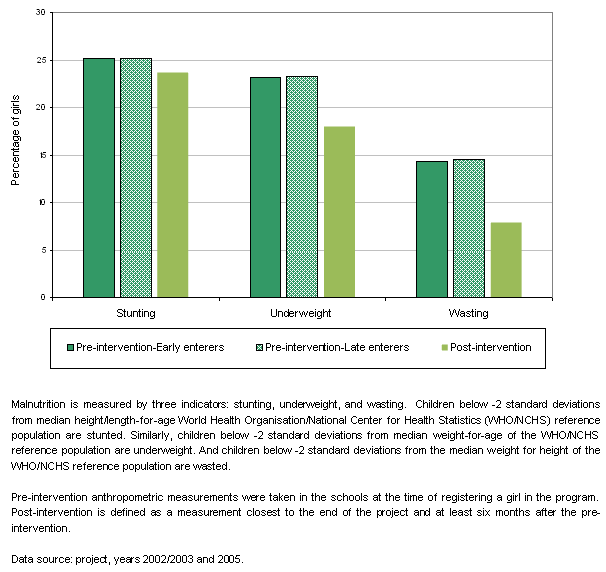
Figure 2: Percentage girls malnourished at the baseline and end of the project (n = 203 116).
To evaluate explanations for the decline in malnutrition, other than the program feeding, we compared girls who entered program early (in late 2002 or early 2003) with girls who entered the program in late 2004. Measures of malnutrition were different by fractions of a percent for girls inducted early and late: 24.6% and 25.2%; wasting 15.1% and 14.5%; underweight 23.1% and 23.3%.
School enrolment for girls increased dramatically (Fig3) by 40% across the program districts. The largest increase was in Punjab (52%), followed by Sindh (37%) and Northern Areas (33%). Analysis of FGDs data showed that 221 of the 246 schools surveyed reported a decline in enrolment after program feeding was suspended. Similarly, Punjab showed the second highest reduction in malnutrition after Northern Areas, with reductions of 31% and 49%, respectively, in underweight and wasting. The large documented improvement in Punjab may be associated with the fact that Punjab is the most developed province in Pakistan with the highest literacy level and lowest gender gap. The Tawana Districts in Punjab, therefore, could be considered to be best prepared to benefit from a program requiring female volunteers. In contrast, Balochistan, where the improvements were less, has the lowest literacy level and the highest gender gap in the country21.
The FGDs suggested that there were a number of improvements in project schools. The number of teachers increased, school discipline improved, and more schools operated to time. Many improvements in schools (improved infrastructure including latrines and water supply) were also documented. Kitchen hygiene in the schools also improved over the course of the project.
The effects of the program extended into the surrounding communities. Poor nutrition in Pakistan is not only due to insufficient calories, but also related to the poor composition of meals. Knowledge of what constitutes a balanced meal increased from 4.7% to 34.4% in community surveys conducted before and after TPP (Fig4).
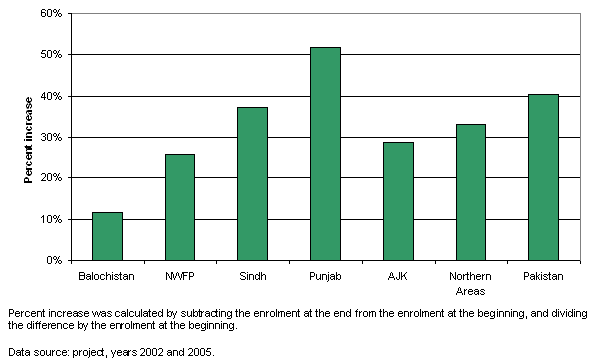
Figure 3: Percent increase in enrolment by province/area (n = 439 852). AJK, Azad, Jammu and Kashmir; NWFP, North West Frontier Province.
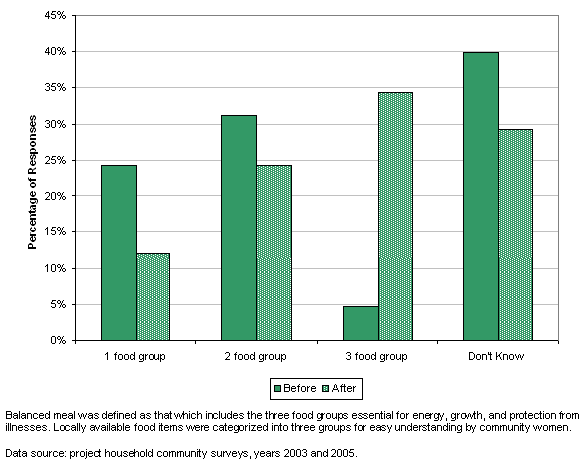
Figure 4: Improvement in community knowledge about balanced meals (n = 3263).
The empowerment of community women was both a strategy and a positive outcome of the project. Approximately 94 000 community women were trained in 3669 formal three-day training sessions for school committees. The average size of these committees was 12 members. Committees met an average of nine times a year. Besides the formal training, committee members also received substantial mentoring during monthly monitoring visits by fieldworkers, and periodic training by NGO district supervisors and AKU monitors. Many of these women obtained their first national identity card, opened and operated a bank account, and left the confines of their villages for the first time.
Discussion
The project demonstrated impressive improvements in nutrition and school enrolment among primary-school girls. The major limitation of the study is the lack of a control group to determine if other factors could explain the observed improvements. The authors believe that having meal at school can generate happiness in children, even if it does not have an effect on malnutrition. Therefore, depriving one group while providing food to another is an ethical issue that makes justifying a control arm in school interventions difficult. However, it was possible to compare the girls inducted early into the feeding program with those inducted late. It was found that both groups had similar levels of malnutrition. This provided an 'internal control' and supported the conclusion that the program was responsible for their improvement. In addition, there were no major changes in Pakistan's development indicators during the 2 years of the study that could be associated with observed changes in nutritional status in this large group of school girls. The fall in school attendance after the feeding program was suspended supports the link between the program and improvements in enrolment.
Another limitation of this analysis was the lack of data on one critical outcome: the learning achievements of the girls. The project was not designed to evaluate learning. An independent evaluation of the project in one province (Sindh), which included control schools, documented improved learning among schools where girl students received feeding22. While improved learning was demonstrated, this should not be a criterion for judgment of the school feeding program because good nutrition is a fundamental human right.
The utility of this large intervention is that it permits evaluation of the capacity of a model to be used at national level. The scale and success of the intervention demonstrates that Pakistan has the human capital necessary to mount an effective program on a national scale. The improvements in nutritional status in this large cohort were achieved despite students in some schools receiving very few feedings, due to local resistance and administrative problems. A fully implemented school feeding program (with a longer implementation periods) may have demonstrated an even stronger impact. The results of this study cannot easily be compared with small-scale pilot studies that have addressed nutrition of primary-school children23,24. There are many models for school feeding, each with a different set of outcome measures. For example, a program that is not based on empowerment and nutritional messages would not be expected to make changes in community involvement and knowledge about nutrition.
The intervention provides a lesson about the synergy between efforts in improving nutrition and health, and in community empowerment. Noble prize winner Amartya Sen stresses these synergies are the key to successful development25. The present model demonstrated the dynamism in moving beyond established administrative structures and academic disciplines. The government should be commended for supporting a program that promoted collaboration between ministries and traditionally separate sectors.
This effort to creatively involve different sectors provided its own lessons. The smooth implementation of the project required clear differentiation among and documentation of the roles of the ministries, NGOs and communities. Numerous problems (including the uneven flow of funds to the community) can be traced to a lack of clarity in roles. Public-private partnerships on this scale in Pakistan are new, and many of the difficulties encountered were due to the lack of clear terms of reference and experience.
Ownership for the project at times created difficulties in implementation. Conflicts between government agencies created major difficulties during implementation of this large-scale project. Sadly, despite the impressive scale and outcome of the project, these forces have overtaken school feeding programs. An alternative 'milk and cookies' program has been proposed to replace the present well-documented, cooked and balanced meal model, to the probable detriment of needy children and their communities.
The Pakistan Government's planning efforts are often impeded by the poor quality of available statistics. For example, the original number of schools targeted by the project was 5300. However, only 85% of the targeted schools actually existed, and even fewer were functional. Similarly, the average number of girls per school/community was below the estimate in the original plan. Investment in statistics in Pakistan will help the Government plan and monitor future projects.
Promoting balanced meals in schools was central to the success of this intervention. Options for future school feeding programs must be carefully weighed. Alternative feeding programs are being discussed in Pakistan. The tendency towards globalization of (Western) dietary patterns, particularly those that include food made with refined sugar, should be avoided. One of the very few health advantages the rural poor of Pakistan possess is having better teeth than urban dwellers26. The addition of refined sugar to the diets of the girls studied will deprive them of the one benefit their society currently offers them. The promotion of sugary snacks also sends the wrong nutritional message to such a vulnerable population. Packaged food programs also miss the empowerment aspects that contributed to the success of the present intervention, which has its own benefits.
Other modalities to improve the nutritional status of girls (de-worming and micronutrient supplements) were piloted during this intervention. These interventions were not acceptable to communities; complaints of vomiting and diarrhoea associated with the tablets led to suspension of these elements. Such school health program modalities should be further piloted and perfected in the future.
Criticism that school feeding programs do not address pre-school malnutrition is misplaced27. A national nutrition policy must address malnutrition at the pre-school and primary-school age periods; there is no basis to favoring one age-level support over another. One of the strengths of the present model is that the entire family benefited, as demonstrated by the shift towards balanced meals in the home. Critics of school feedings programs mentioned the 'politically popularity' of school feeding programs, as if that was a fault in itself. Political viability is critical, however, to the success of any large scale program. The Government of Pakistan has recently dramatically increased the social welfare sector budget, demonstrating a willingness to address the serious problems of the poor28, while also having difficulty spending such budgets. Expanding and fully funding this successful project is strongly supported by the evidence presented in this article.
Conclusion
This study demonstrates the potential success and scalability of school feeding programs in Pakistan. The success of the program can be explained by the considerable synergies that are found when communities are encouraged to work across sectors (health, education and empowerment). The major challenges encountered in this large-scale project reflect this same intersectoral nature of the projects.
Acknowledgements
The authors acknowledge the foresightedness and resolve of the Ministry of Social Welfare and Special Education, and the Government of Pakistan in funding the project. Special appreciation is extended to our partner NGOs in mobilizing, training and mentoring communities, without which the project would not have been possible. Also acknowledged are the efforts of Dr Latif Tareen who spearheaded the pre- and post-intervention KAPS surveys in the field. Zeeshan Saeed is thanked for managing the MIS databases of the project. Last but not least, the authors pay tribute to all the community women, teachers and the children who participated in and benefited from the project, and were instrumental in its success.
References
1. Khuwaja S, Selwyn BJ, Shah SM. Prevalence and correlates of stunting among primary school children in rural areas of southern Pakistan. Journal of Tropical Pediatrics 2005; 51: 72-77.
2. Government of Pakistan, Statistics Division, Federal Bureau of Statistics Islamabad. Pakistan Social and Living Standards Measurement Survey (2004-05) . (Online) 2005. Available: http://www.statpak.gov.pk/depts/fbs/statistics/pslm2004-05/pslm2004-05.html (Accessed 31 May 2006).
3. World Bank. Pakistan Country Overview 2006. (Online) 2006. Available from: http://econ.worldbank.org/WBSITE/EXTERNAL/EXTDEC/EXTRESEARCH/
EXTPROGRAMS/EXTTRADERESEARCH/0,,contentMDK:20131431~isCURL:Y~menuPK:51428254~pagePK:210082~piPK:210098~theSitePK:544849,00.html (Accessed 26 September 2007).
4. Main RM, Ali M, Ferroni PA, Underwood P. The Nutritional Status of School-Aged Children in an Urban Squatter Settlement in Pakistan. Pakistan Journal of Nutrition 2002; 1(3): 121-123.
5. World Health Organization. The multi-country evaluation of IMCI effectiveness, cost and impact. (MCE) Progress Report May 2000-April 2001. The Multi-Country Evaluation-Gates Report 2000. Geneva, WHO, 2001.
6. World Bank. World development report, 1997: the state in a changing world. Washington, DC: World Bank, 1997.
7. UNICEF. Unmasking malnutrition. Progress of the nations. New York: Oxford University Press, 1996.
8. Rose D, Martorell R. The impact of protein-energy supplementation interventions on child morbidity and mortality In: Child Health Priorities for the 1990s. Baltimore, MD: The Johns Hopkins University School of Hygiene and Public Health, 1989; 191-214.
9. Martorell R, Rivera JA, Lutter C. Interaction of diet and disease in child growth. In: SA Atkinson, LA Hanson, RK Chandra (Eds). Breastfeeding, nutrition, infection and infant growth in developed and emerging countries. St John's, Newfoundland: ARTS Biomedical, 1990; 307-321.
10. Beaton GH. Design of nutrition monitoring and surveillance systems: questions to be considered. Journal of the Canadian Dieticians Association 1990; 51: 472-474.
11. Gorman KS, Pollitt E. Relationship between weight and body proportionality at birth, growth during the first year of life and cognitive development at 36, 48, and 60 months. Infant Behavior and Development 1992; 15: 279-296.
12. Royston E, Armstrong S. Preventing maternal deaths. WHO: Geneva, 1989.
13. Fikree FF, Berendes HW, Midhet F, D'Souza RM, Hussain R. Risk factors for intrauterine growth retardation: results of a community-based study from Karachi. Journal of the Pakistan Medical Association 1994; 44: 30-34.
14. Haas JD, Murdoch S, Rivera J, Martorell R. Early nutrition and later physical work capacity. Nutrition Reviews 1996; 54: S41-S48.
15. Institute for Educational Development, The Aga Khan University and The University of Bristol and Oslo College. NORAD's support to primary education in Pakistan: some lessons from experience. Karachi: The Aga Khan University and The University of Bristol, 1988.
16. Government of Pakistan. Demographic indicators - census, Population Census Organization. (Online) 1998. Available: http://www.statpak.gov.pk/depts/pco/statistics/statistics.html (Accessed 31 May 2006).
17. Government of Pakistan, Finance Division: Economic Advisor's Wing. Economic Survey of Pakistan 2005-2006. (Online) 2006. Available: http://www.finance.gov.pk/ (Accessed 31 May 2006).
18. United Nations. Focusing resources on effective school health: a FRESH start to enhancing the quality and equity of education. Geneva: UNESCO, UNICEF, WHO, and the World Bank, 2000.
19. Aga Khan University, Department of Community Health Sciences. Tawana Pakistan Program: research and projects. (Online) 2007. Available: http://www.aku.edu/CHS/chs-resandev.shtml (Accessed 13 August 2008).
20. World Health Organization. Physical status: the use and interpretation of anthropometry. WHO technical report series no 854. Geneva: WHO, 1995.
21. Hussain, Fazal and Qasim, Ali M. Inequality in the literacy levels in Pakistan: existence and changes. (Online) 2007. Available: http://mpra.ub.uni-muenchen.de/4166/1/MPRA_paper_4166.pdf (Accessed 28 May 2008).
22. Soofi S, Hlibi I, Feroz A, Bhutta Z. Report on impact assessment and evaluation of Tawana Pakistan Project. Sindh Province: Department of Pediatrics, Aga Khan University, 2006.
23. Grantham-McGregor SM, Chang S, Walker SP. Evaluation of school feeding programs: some Jamaican examples. American Journal of Clinical Nutrition 1998; 67: 785S-789S.
24. Weinberger K. The impact of iron bioavailability-enhanced diets on health and nutrition of school children: evidence from a mungbean feeding trial in Tamil Nadu. In: Proceedings, Why has impact assessment research not made more of a difference; 4-7 February 2002; San José, Costa Rica. Available: http://www.avrdc.org/pdf/TB30.pdf (Accessed 18 August 2006).
25. Sen A. Development as freedom. Oxford: Oxford University Press, 1999.
26. Hadden WC, Pappas G, Khan AQ. Social stratification, development and health in Pakistan: an empirical exploration of relationships in population-based national health examination survey data. Social Science and Medicine 2003; 57: 1863-1874.
27. Dugger CW. Report warns malnutrition begins in cradle. New York Times 2006; 3 March, 6 SectA. (Online) 2006. Available: http://www.nytimes.com/2006/03/03/health/03hunger.html
28. Kiani K. PSDP utilisation only 50pc. Daily DAWN Newspaper 2006; 20 May, 1.
Abstract
Introduction: Malnutrition and low levels of education continue to be major problems in many developing countries, especially for female children.
Methods: In Pakistan, a large-scale school lunch program was implemented in 29 of the poorest rural districts through a public-private partnership. The project provided freshly prepared meals in 4035 government primary girls' schools over a 2 year period. The primary strategy was empowerment of women in the community who volunteered to plan the meals, purchase the food, and cook and serve the meals. The project collected data from growth monitoring, attendance records, pre- and post-intervention community based surveys, focus group discussions, and the use of other ethnographic methods. A study on changes in the levels of malnutrition was based on an analytical sample of 203 116 girls who received at least two sets of body measurements at least 6 months apart.
Results: Over the intervention period, wasting declined by almost half and school enrolment increased by 40%. Girls who entered the program early were found to have similar levels of malnutrition to girls who entered late, suggesting that factors external to the program were not associated with the decrease in malnutrition.
Conclusion: This study demonstrates the potential success and scalability of school feeding programs in Pakistan. Lessons learned include that synergies are found when working across sectors (health, education, and empowerment) and that there are challenges to intersectoral projects. Globalization may undermine this successful model as Pakistan considers expanded school feeding programs.
Key words: female children, nutrition, Pakistan.
You might also be interested in:
2019 - Rural women’s first-person perspectives on the role of mental health in substance use
2019 - Analysis of a decade of skin cancer prevention using a mobile unit
